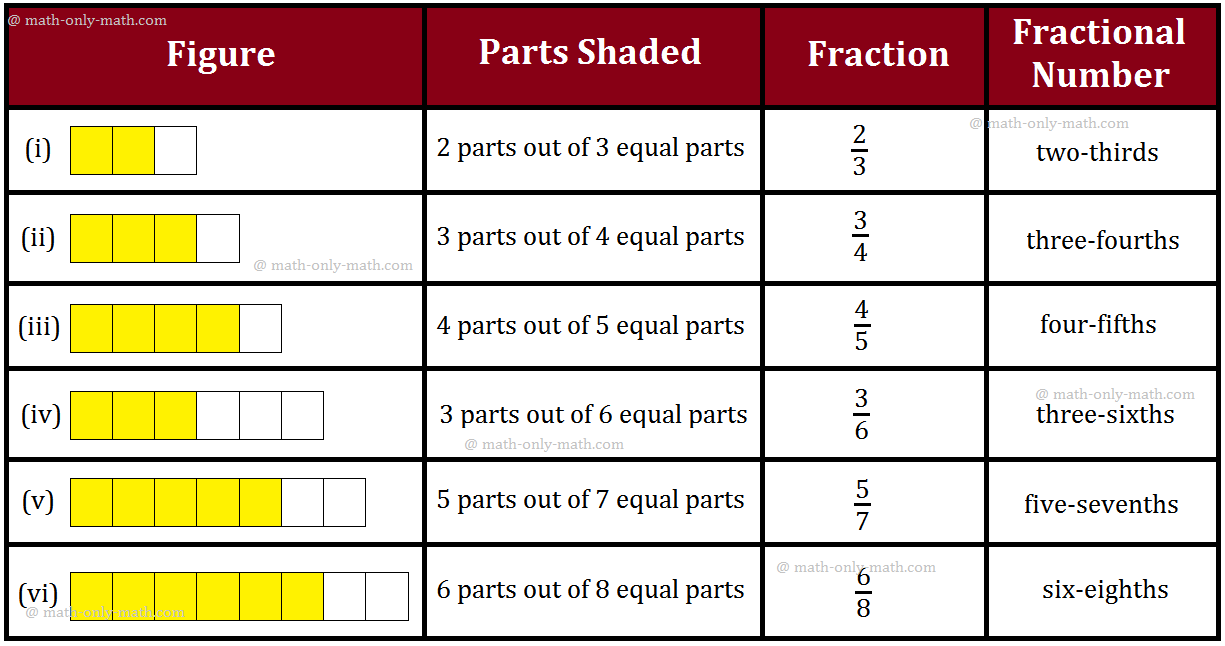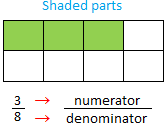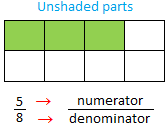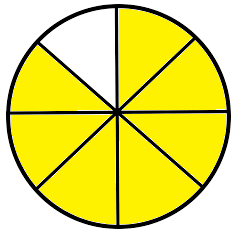Subscribe to our ▶️ YouTube channel 🔴 for the latest videos, updates, and tips.
Identification of the Parts of a Fraction
We will discuss here about the identification of the parts
of a fraction. We know fraction means part of something. Fraction tells us,
into how many parts a whole has been divided and the part which is considered
out of the whole.
We also know that the numbers 0, 1, 2, 3, ........... are called whole numbers and the numbers ½, 1/3, ¼, 1/5, 1/6, ........... are called fractional numbers.
Each of the fractional number has two numbers separated by a ‘-‘ (dash) called the bar which means divided.
The number above the bar is called the numerator. It tells us as to how many parts have been considered
out of the total equally divided parts.
The number below the bar is called the denominator. It describes us as in how many parts a whole has been
divided.
This rectangle which is considered as a whole.
It is divided into 8 parts. This 8 represents the
denominator of a fraction.
Three parts are shaded. This 3 represents the numerator.
So, the fraction of the shaded part is \(\frac{3}{8}\).
Also in this figure, 5 parts are not shaded.
Therefore,
fraction of the unshaded parts is \(\frac{5}{8}\). Here 5 is the numerator and 8 is the
denominator in the fraction.
|
In this figure, a circle is divided into 8 equal parts and 7 parts are shaded.
The shaded part represents seven eighths of the circle. In symbols, we write it as \(\frac{7}{8}\) Seven-eighths is called a fractional number.
\(\frac{7}{8}\) is called a fraction. The unshaded part represents one-eighths of the circle. In symbols, we write it as \(\frac{1}{8}\)
|
|

You might like these
To convert a percentage into a fraction, place the given number over 100 and reduce it to its lowest term. Consider the following example: (i) 20% [We know % = 1/100]
To convert a mixed number into an improper fraction, we multiply the whole number by the denominator of the proper fraction and then to the product add the numerator of the fraction to get the numerator of the improper fraction. I
The three types of fractions are : Proper fraction, Improper fraction, Mixed fraction, Proper fraction: Fractions whose numerators are less than the denominators are called proper fractions. (Numerator < denominator). Two parts are shaded in the above diagram.
In 5th Grade Fractions we will discuss about definition of fraction, concept of fractions and different types of examples on fractions. A fraction is a number representing a part of a whole. The whole may be a single object or a group of objects.
In word problems on fraction we will solve different types of problems on multiplication of fractional numbers and division of fractional numbers.
In conversion of improper fractions into mixed fractions, we follow the following steps: Step I: Obtain the improper fraction. Step II: Divide the numerator by the denominator and obtain the quotient and remainder. Step III: Write the mixed fraction
The fractions having the same value are called equivalent fractions. Their numerator and denominator can be different but, they represent the same part of a whole. We can see the shade portion with respect to the whole shape in the figures from (i) to (viii) In; (i) Shaded
To find the difference between like fractions we subtract the smaller numerator from the greater numerator. In subtraction of fractions having the same denominator, we just need to subtract the numerators of the fractions.
Any two like fractions can be compared by comparing their numerators. The fraction with larger numerator is greater than the fraction with smaller numerator, for example \(\frac{7}{13}\) > \(\frac{2}{13}\) because 7 > 2. In comparison of like fractions here are some
In comparison of fractions having the same numerator the following rectangular figures having the same lengths are divided in different parts to show different denominators. 3/10 < 3/5 < 3/4 or 3/4 > 3/5 > 3/10 In the fractions having the same numerator, that fraction is
In worksheet on comparison of like fractions, all grade students can practice the questions on comparison of like fractions. This exercise sheet on comparison of like fractions can be practiced
Like and unlike fractions are the two groups of fractions: (i) 1/5, 3/5, 2/5, 4/5, 6/5 (ii) 3/4, 5/6, 1/3, 4/7, 9/9 In group (i) the denominator of each fraction is 5, i.e., the denominators of the fractions are equal. The fractions with the same denominators are called
Fraction of a whole numbers are explained here with 4 following examples. There are three shapes: (a) circle-shape (b) rectangle-shape and (c) square-shape. Each one is divided into 4 equal parts. One part is shaded, i.e., one-fourth of the shape is shaded and three
Representation of a fraction is discussed here. In a simple fraction, there is a horizontal line. Above this line we write a number which is called the numerator. Below this line we write another number which is called the denominator.
In worksheet on fractions, all grade students can practice the questions on fractions on a whole number and also on representation of a fraction. This exercise sheet on fractions can be practiced
3rd Grade Math Worksheets
3rd Grade Math Lessons
From Identification of the Parts of a Fraction to HOME PAGE
Didn't find what you were looking for? Or want to know more information
about Math Only Math.
Use this Google Search to find what you need.
Share this page:
What’s this?




![To convert a percentage into a fraction, place the given number over 100 and reduce it to its lowest term. Consider the following example: (i) 20% [We know % = 1/100]](/image-thumbnails/convert-a-percentage-into-a-fraction.png/default.webp)















New! Comments
Have your say about what you just read! Leave me a comment in the box below. Ask a Question or Answer a Question.